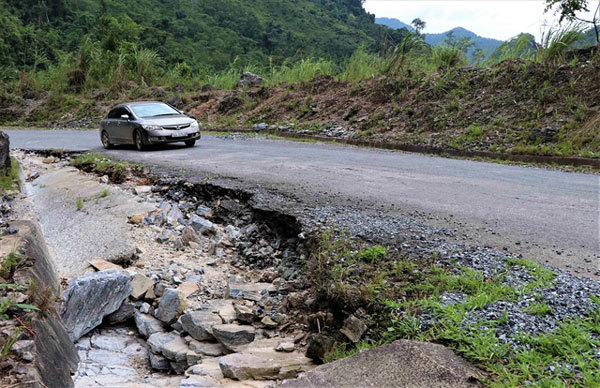NA Standing Committee proposes cutting road fees
Dozens of taxes, fees burden VN car users
 |
| A car is seen passing a damaged section of the Khau Lac pass in the northern mountainous province of Tuyen Quang. — VNA/VNS Photo Quang Dan |
The Viet Nam Register (VR) – a Governmental body responsible for technical inspection and licensing of vehicles, under the transport ministry – stressed that all of its registration centres across the country make this known to vehicle owners, as many mistakenly think they would no longer have to pay the fees, which are usually paid at VR centres during vehicle inspections.
The confusion came after a supervision group from the National Assembly Standing Committee suggested retiring a total of six funds, including the road maintenance fund, citing inefficient operations or overlapping duties.
According to VR, since 2017, all road use fees that vehicle owners pay would go into the State budget, instead of the central road maintenance fund like in 2013-16. And then the fund will receive money from the State budget to hand down to units and agencies involved in road maintenance work. The amount the fund receives from the State budget will depend on the estimates stated in a plan the Directorate for Roads of Viet Nam draws up that covers all maintenance projects to be carried out in the year, after being reviewed by the road maintenance funds, finance ministry, investment and planning, and the automobile association.
Since the fund does not have any source of income other than State budget’s allocation and its role is a mere ‘middle-man collector and distributor’ of budget, the NASC supervision group has suggested scrapping the fund altogether.
Road use fees were specified in the Law on Fee and Charge and an importance source of revenues for the maintenance of the national road infrastructure system, VR said in the document sent to its local centres, adding that the Government had not signalled intention or issued any document asking for a halt on collecting road use fees.
Deputy transport minister Le Dinh Tho previously received complaints from local authorities about the middleman role of the road maintenance fee management council and its problematic and opaque “xin-cho” nature (request-and-give mechanism).
Since 2018, the transport ministry has proposed the Government should abolish the fund’s management body.
Le Hoang Minh, chief of office of the Viet Nam Road Maintenance Fund, said that the abolishment proposal was actually aimed at restructuring the fund’s organisation and adjusting its revenues and budget allocation model to fit in line with the current law.
The establishment of the fund in 2013 was because the constrained State budget could not meet the maintenance of roads all over the country at the time, Minh said.
Additionally, compared to lengthy approval and disbursement procedures involved in projects using State budget, the fund’s more flexible and easier procedures have resulted in quicker repairs and more timely maintenance for roads. “Since the establishment of the fund, the numbers of traffic accidents and deaths have dropped,” Minh said, arguing that the fund still has its role to play and the NASC only wants to make the fund more effective.
Minh said the fate of the fund would depend on the resolution passed by the NASC.
VNS
 Transport authorities said last week that car owners would still have to pay road use fees, even if the road maintenance fund is abolished.
Transport authorities said last week that car owners would still have to pay road use fees, even if the road maintenance fund is abolished.